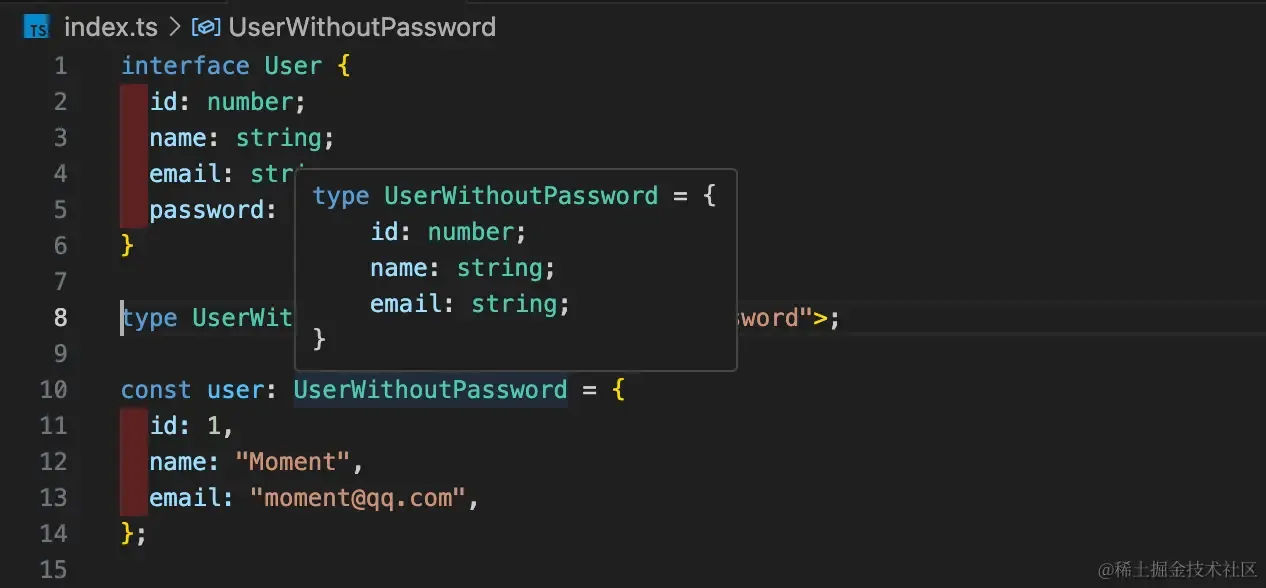Omit 是 TypeScript 提供的一个高级类型工具,用于从一个类型中排除指定的键,从而构造一个新的类型。它在处理对象类型时非常有用,可以帮助你轻松创建不包含某些特定属性的类型。
它的主要使用场景有以下几个方面:
-
去除不需要的属性:当你有一个类型,但不需要其中的一些属性时,可以使用 Omit 去除这些属性。
-
创建子类型:从一个大型类型中派生出较小的子类型,只包含某些特定的属性。
Omit 的基本使用
假设我们有一个用户类型 User:
interface User {
id: number;
name: string;
email: string;
password: string;
}我们可以使用 Omit 创建一个新的类型,该类型不包含 password 属性:
type UserWithoutPassword = Omit<User, 'password'>;
const user: UserWithoutPassword = {
id: 1,
name: 'Moment',
email: 'moment@qq.com',
};
我们还可以排除多个属性,只需将属性名用联合类型 | 连接起来:
type BasicUserInfo = Omit<User, 'email' | 'password'>;
const basicUser: BasicUserInfo = {
id: 1,
name: 'moment',
};
Omit 的基本实现
Omit 的定义如下:
type Omit<T, K extends keyof any> = Pick<T, Exclude<keyof T, K>>;在上面的代码中 T 是一个泛型,代表一个对象类型。K 是一个泛型,代表要从 T 中剔除的键。K 必须是 keyof any 的子集,也就是说,K 可以是任何类型的键。
Pick<T, Exclude<keyof T, K>> 从类型 T 中挑选出 Exclude<keyof T, K> 中的键。
进阶使用
动态类型与 Omit 结合使用
结合条件类型和 Omit 可以实现更加动态的类型操作。
interface User {
id: number;
name: string;
email: string;
password: string;
}
type ConditionalOmit<T, K extends keyof any, U> = T extends U ? Omit<T, K> : T;
type AdminUser = User & { admin: true };
type RegularUser = User & { admin?: false };
type UserWithoutPassword<T> = ConditionalOmit<T, 'password', { admin?: false }>;
const adminUser: UserWithoutPassword<AdminUser> = {
id: 1,
name: 'moment',
email: 'moment@qq.com',
password: 'moment',
admin: true,
};
const regularUser: UserWithoutPassword<RegularUser> = {
id: 2,
name: 'm',
email: 'm@qq.com',
// password 被省略
};在上面的这些代码中包含了一个条件类型 ConditionalOmit:
type ConditionalOmit<T, K extends keyof any, U> = T extends U ? Omit<T, K> : T;它的主要作用是用于根据某些条件有选择性地移除类型中的属性:
-
T 是输入类型。
-
K 是要移除的属性。
-
U 是条件类型。
条件类型 T extends U ? Omit<T, K> : T 的含义是:
-
如果 T 可以赋值给类型 U,则从 T 中移除属性 K(通过
Omit<T, K>实现)。 -
否则,保留类型 T 不变。
最终实现有条件移除 Password 属性的类型 UserWithoutPassword:
-
如果 T 满足 { admin?: false } 条件(即普通用户),则移除 T 中的 password 属性。
-
否则(即管理员用户),保留 T 不变。
递归 Omit
通过递归类型实现嵌套类型的 Omit 操作。
interface NestedObject {
id: number;
details: {
name: string;
email: string;
address: {
street: string;
city: string;
};
};
}
type DeepOmitHelper<T, K extends keyof any> = {
[P in keyof T]: P extends K
? never
: T[P] extends infer TP
? TP extends object
? DeepOmit<TP, K>
: TP
: never;
};
type DeepOmit<T, K extends keyof any> = Pick<
DeepOmitHelper<T, K>,
{
[P in keyof DeepOmitHelper<T, K>]: DeepOmitHelper<T, K>[P] extends never ? never : P;
}[keyof DeepOmitHelper<T, K>]
>;
type NestedWithoutEmail = DeepOmit<NestedObject, 'email'>;
const nestedObject: NestedWithoutEmail = {
id: 1,
details: {
name: 'moment',
address: {
street: '中山大道',
city: '珠海',
},
},
// email 被省略
};对于上面的代码主要有以下几个方面的解释:
-
DeepOmitHelper 类型:
-
DeepOmitHelper 是一个辅助类型,用于处理嵌套对象。
-
对于每个属性 P,如果 P 是要删除的属性 K,则将其类型设置为 never。
-
如果属性 P 是一个对象,则递归应用 DeepOmit。
-
否则,保持属性类型不变。
-
-
DeepOmit 类型:
-
使用 Pick 和映射类型来删除被设置为 never 的属性。
-
Pick<DeepOmitHelper<T, K>, {...}>从 DeepOmitHelper 中挑选出所有非 never 的属性键,创建一个新的类型。
-
最终实现 NestedWithoutEmail 类型是从 NestedObject 中递归删除 email 属性后的结果。
使用 Omit 构建 REST API 响应类型
在构建 REST API 时,常常需要对请求和响应的类型进行严格的控制。
interface User {
id: number;
name: string;
email: string;
password: string;
createdAt: Date;
updatedAt: Date;
}
// 创建一个请求体类型,省略 id 和时间戳
type CreateUserRequest = Omit<User, 'id' | 'createdAt' | 'updatedAt'>;
const newUser: CreateUserRequest = {
name: 'moment',
email: 'moment@qq.com',
password: 'moment',
};
// 创建一个响应体类型,省略 password
type UserResponse = Omit<User, 'password'>;
const userResponse: UserResponse = {
id: 1,
name: 'moment',
email: 'moment@qq.com',
createdAt: new Date(),
updatedAt: new Date(),
// password 被省略
};总结
Omit 是一个非常强大的工具类型,通过结合条件类型、联合类型、递归类型和映射类型等高级类型特性,可以实现复杂的类型操作。它在很多场景下都非常有用,例如创建请求和响应类型、动态属性过滤、构建嵌套对象类型等。通过灵活运用 Omit,可以使 TypeScript 代码更加灵活和类型安全,提高代码的可维护性和可读性。